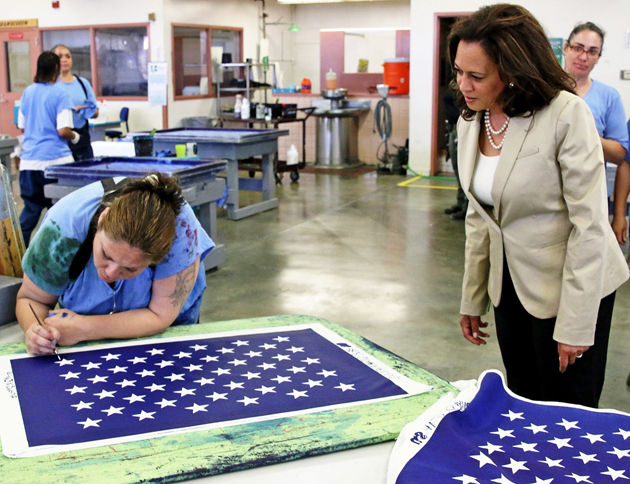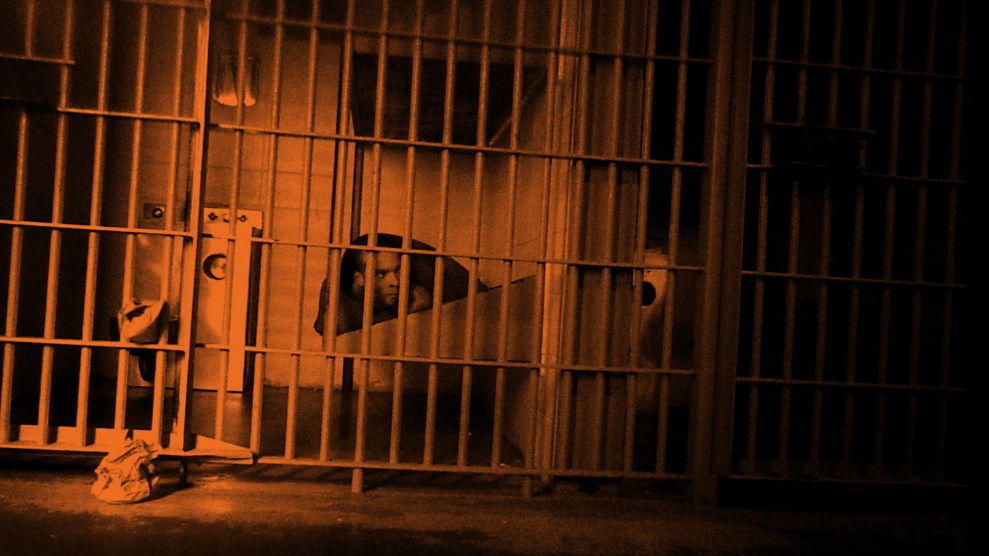Sen. Kamala Harris visits a prison in California, where inmates manufacture American flags.
Every generation or so, the American flag becomes a flashpoint in civic discourse. In recent memory, it’s been held aloft by civil rights marchers and burned by critics of the Vietnam War. It became a show of unity after 9/11 and, some would argue, a symbol of militarism as US intervention ramped up in the years after 2001. Today, it represents a country deeply divided along partisan lines, led by a man who disguises bigoted populism as patriotism. It’s also a symbol for a resurgent movement of white nationalists who cloak their hate in the stars and stripes, even as they defend Confederate monuments. And for countless others, it’s a symbol of a country that’s still a work in progress—work that they’re proud and humbled to do.
But the American flag is more than a symbol. It’s a product. And for nearly a century, it’s been among the dozens of things made by incarcerated men and women inside America’s prisons.
On Sunday, California Sen. Kamala Harris (D) paid a visit to Atlanta, where she helped celebrate the 150th anniversary of First Congregational Church, a famed African American institution that is one of the few surviving places of worship that once catered to newly freed blacks after the Civil War. She touched on the national anthem protests that have recently swept across the NFL, calling them—and the “fight for the equality of each and every one of us”—patriotic. And then she said this:
When we sing the Star Spangled Banner, we rightly think about brave men and women from all backgrounds who proudly defend the freedom of those they may never meet and people who will never know their names.
When we sing the Star Spangled Banner, we also think about those marching in the streets who demand that the ideals of that flag represent them too…And we think about women like the women I recently visited at a California state prison. They were making American flags. The kind you see waving over the United States Capitol or down the street at the Georgia state Capitol.
Harris was referring to the visit she made to the Central California Women’s Facility in July, a visit on which I tagged along. It was a surreal experience to watch dozens of women, mostly women of color, at work stations inside of the country’s largest prison for women, laying out and printing fabric and then dyeing it royal blue. It was just as surreal, if not more so, to hear prison officials point out that these flags would one day fly atop every state and federal building in California, describing this with something almost adjacent to pride.
I was born and raised in California and certainly took my fair share of California history classes from elementary school through college. In high school, I marched in protests against Proposition 21, the 2000 ballot initiative that made it easier to prosecute young people, and I was educated by the types of teachers who gave extra credit for attending demonstrations in downtown San Francisco against the Iraq War. But even I was surprised to learn that our country’s symbols of freedom were made by women who had none.
There are more than 2.2 million people incarcerated inside of America’s adult prisons, according to the Bureau of Justice Statistics. California’s prison population is notorious for its size—so much so that the Supreme Court ruled in 2011 that the overcrowded conditions were unconstitutional and ordered the state to reduce its inmate population by more than 30,000. At the time, California’s prison system was operating at nearly double the capacity it was originally built to house, and photos of rows of bunk beds lining gymnasiums spoke to the growing crisis. The surge in prison populations had largely happened in the 1980s and 1990s; as drugs flooded black neighborhoods, state legislatures adopted “tough on crime” policies and mandatory minimum sentences. For its part, California passed a “three strikes” law that put people away for life for relatively minor offenses.
All of this disproportionately affected communities of color. Oftentimes that was by design. Hillary Clinton called some young people “superpredators” in the late-1990s while she was supporting Bill Clinton’s disastrous crime bill. In 1989, Donald Trump took out a full-page newspaper ad calling for the death penalty to be reinstated in response to the infamous Central Park jogger case. (The black teenagers imprisoned for that crime were later exonerated, but Trump has continued to insist they were guilty.)
That sort of racial coding wasn’t atypical for the time. It was the norm. And the resurgent white nationalism among some Trump supporters proves that it still is. Trump played on white America’s deepest racial anxieties about inner-city crime during his campaign.
Today, the federal and state agencies where racial disparities play out most prominently are America’s jails and prisons. Two-thirds of the women behind bars in America are women of color. They often are unemployed before being convicted and are struggling with addiction or mental illness, according to a report from the Vera Institute for Justice.
Many of these prisoners make a wide range of products that we often take for granted in our daily lives: the mattresses we sleep on, the furniture in our college dorm rooms, the circuit boards that power our favorite gadgets. They make dentures for the elderly and even fight our most vicious wildfires. They do this work for literal pennies on the dollar. When and if they’re released, their criminal records often disqualify them from finding work in the industries that shaped their lives on the inside.
At the church in Atlanta, Harris insinuated that making those flags was a form of patriotism, not just penance. “That day when I was looking at those women and talking with them, they were doing everything…from cutting the fabric to silk-screening and pushing the paint through the stars and the stripes,” Harris said. “And I thought, ‘Yes, certainly they have made mistakes, but that’s their flag too.'”
I’d take that one step further.
At its heart, the fights over the American flag are really battles over whose labor to “make America great again” we can and should recognize. It’s hard to reconcile that people without freedom are responsible for creating our symbols of it. But it’s a sign of what America has always been: a land in which freedom is only given to some.













